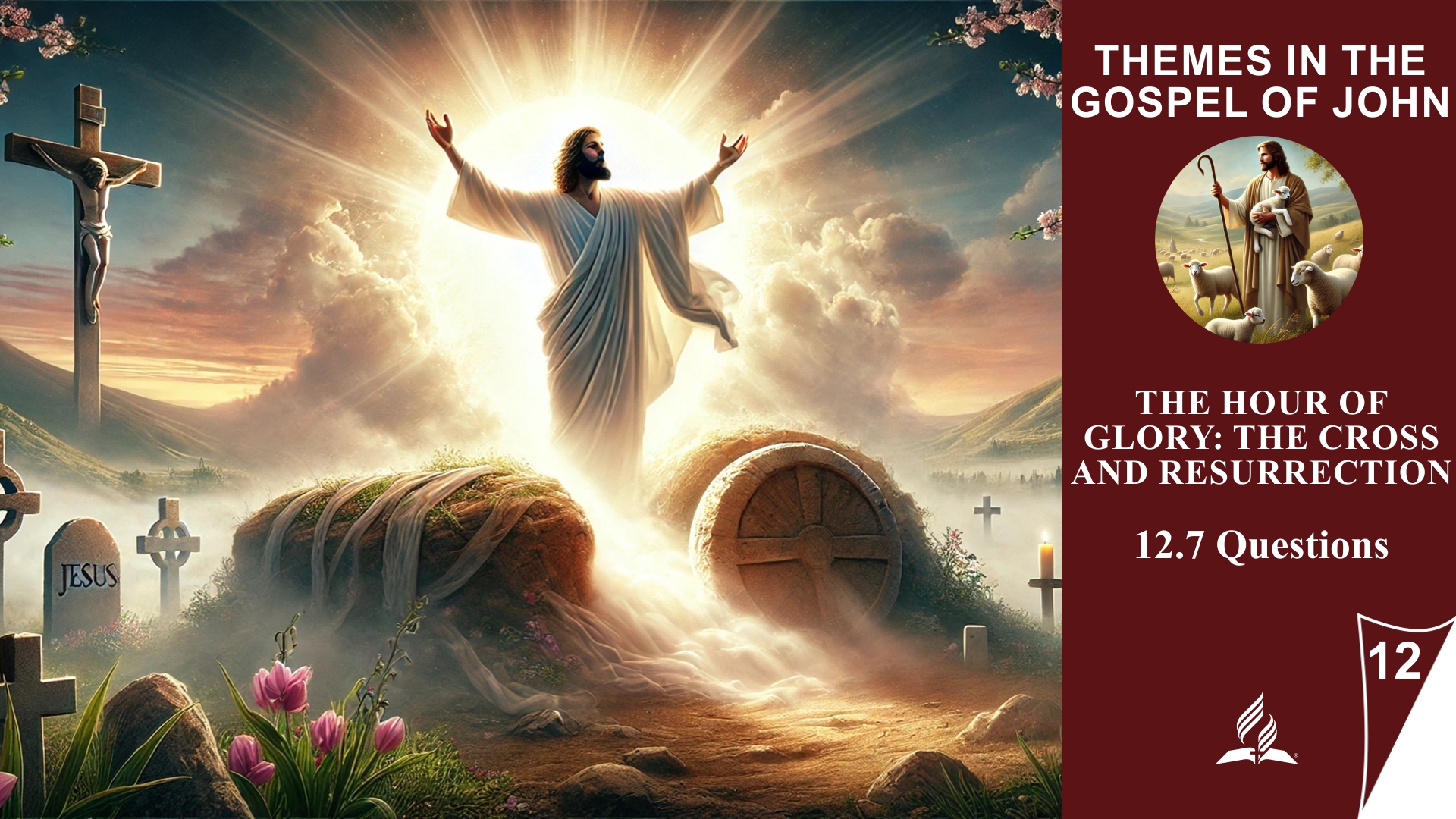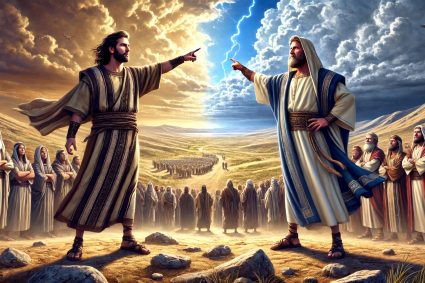



1.What decision-making processes can help you avoid the type of mistakes that Pilate made?
Pilate was in a difficult situation where he had to make a decision under the pressure of the crowd and the religious leaders. His mistakes—uncertainty, fear of consequences, and the attempt to please everyone—can serve as a warning. To avoid such mistakes, the following decision-making processes can be helpful:
-
Prioritize Truth and Principles
-
-
Pilate’s Mistake: He recognized the truth but did not act accordingly out of fear of consequences.
-
Approach: Develop a solid foundation of values and principles to guide you. Prioritize the truth, even when it is uncomfortable. Ask yourselves: “What is right, not just what is easy?”
-
-
Courage to Decide
-
-
Pilate’s Mistake: He tried to shift responsibility instead of making a clear decision.
-
Approach: Take responsibility for your decisions, even when they are difficult. Be willing to act even when the consequences are challenging.
-
-
Careful Consideration
-
-
Pilate’s Mistake: He was influenced by the loudness of the crowd and external pressure.
-
Approach: Take the time to thoroughly analyze the situation. Listen to different opinions, but do not let loud voices or group pressure guide you. Ask yourself: “What is the long-term effect of my decision?”
-
-
Seek Counsel
-
-
Pilate’s Mistake: He seemed isolated and allowed himself to be influenced solely by the crowd.
-
Approach: Seek wise and trustworthy advisors who can support you in difficult decisions. Talk to people who have moral integrity and can help you think clearly.
-
-
Recognize Majority Pressure
-
-
Pilate’s Mistake: He acted out of fear of an uprising and gave in to majority pressure.
-
Approach: Learn to distinguish between doing what is right and making popular decisions. Practice saying “No” when the majority takes a morally wrong path.
-
-
Seek God’s Will
-
-
Pilate’s Mistake: He did not consider that Jesus was the bearer of truth and ignored divine principles.
-
Approach: Pray and seek God’s wisdom in your decision-making. Reflect on the question: “Does my decision align with God’s will and His principles?”
-
-
Develop Backbone
-
-
Pilate’s Mistake: He wanted to avoid conflict and made compromises that betrayed justice.
-
Approach: Practice making decisions that stand by your convictions, even if it means facing opposition. Ask yourself: “What would I do if no one agreed with me?”
-
Conclusion
Mistakes like Pilate’s often arise from fear, pressure, or the pursuit of convenience. By prioritizing truth and principles, seeking God’s will, and being willing to take responsibility, you can avoid such errors. Decisions based on truth, courage, and integrity lead to long-term peace and justice.
2.Why did Jesus have to die in our place? Why did he have to be our substitute? Why was his death necessary for us to be redeemed? Which Bible verses support your answer?
Jesus had to die in our place because only through His sacrifice could the separation between God and humanity be overcome. His death was necessary to bear the sin of the world, pay the penalty for our guilt, and reconcile us with God.
-
The Necessity of a Substitute
-
-
Sin Separates Us from God: Since the fall (Genesis 3), humanity has been separated from God by sin. The Bible teaches that “the wages of sin is death” (Romans 6:23). Death is not only physical but also eternal separation from God.
-
God’s Justice Requires Atonement: God is perfectly just and cannot simply ignore sin (Psalm 89:15). It was necessary for someone to pay the penalty for sin to satisfy God’s justice.
-
Jesus as Our Substitute: Since we could not bear this guilt ourselves, Jesus, who is sinless, had to die as our substitute (1 Peter 2:24).
-
-
Why His Death Was Necessary for Our Redemption
-
-
The Perfect Sacrifice: In the Old Testament, animal sacrifices were offered for the atonement of sins (Leviticus 17:11). However, these sacrifices were only temporary shadows. Jesus is the “Lamb of God who takes away the sin of the world” (John 1:29). His death was the final and perfect sacrifice (Hebrews 10:10).
-
Reconciliation with God: Through His death, Jesus bore the punishment for our sins, freed us from guilt, and reconciled us with God (Romans 5:10). “For He made Him who knew no sin to be sin for us, so that in Him we might become the righteousness of God” (2 Corinthians 5:21).
-
Victory Over Death: Jesus’ death and resurrection defeated death and the power of evil (1 Corinthians 15:55–57). His sacrifice opens the way to eternal life for all who believe in Him (John 3:16).
-
Bible Verses Supporting This
-
John 3:16: “For God so loved the world that He gave His one and only Son, that whoever believes in Him shall not perish but have eternal life.”
-
Meaning: God’s love motivated Him to send His Son as a sacrifice for our salvation.
-
-
Isaiah 53:5: “But He was pierced for our transgressions, He was crushed for our iniquities; the punishment that brought us peace was on Him, and by His wounds we are healed.”
-
Meaning: Jesus bore the punishment for our sins and brought healing and peace.
-
-
1 Peter 2:24: “He Himself bore our sins in His body on the tree, that we might die to sin and live to righteousness. By His wounds you have been healed.”
-
Meaning: Jesus carried our sins and gave us the opportunity to live righteously.
-
-
Romans 5:8: “But God demonstrates His own love for us in this: While we were still sinners, Christ died for us.”
-
Meaning: Jesus died to make God’s love and redemption visible, even though we did not deserve it.
-
-
Hebrews 9:22: “In fact, the law requires that nearly everything be cleansed with blood, and without the shedding of blood there is no forgiveness.”
-
Meaning: Jesus’ death was necessary to enable the forgiveness of sins.
-
-
2 Corinthians 5:21: “For He made Him who knew no sin to be sin for us, so that in Him we might become the righteousness of God.”
-
Meaning: Jesus’ death made it possible for us to stand righteous before God.
-
Conclusion
Jesus had to die in our place because we could not bear the punishment for our sins. His death was the only perfect sacrifice that fulfilled God’s justice and provided us with redemption. Through His death and resurrection, He offers us the opportunity to live in a renewed relationship with God and receive eternal life. This is the foundation of our faith and the greatest revelation of God’s love.
3.What is the relationship between the evidence from Holy Scripture and the historical evidence when it comes to the belief in Jesus’ resurrection? Which historical evidence strongly confirms the resurrection of Jesus?
The biblical and historical evidence complement each other and together contribute to the credibility of Jesus’ resurrection. Scripture provides the theological and prophetic foundation, while historical evidence supports the events from an objective perspective.
-
Evidence from Holy Scripture
The Bible attests to Jesus’ resurrection through eyewitness accounts, prophetic fulfillments, and the apostles’ proclamation. It not only provides historical data but also shows the spiritual significance of the resurrection.
-
Prophetic Fulfillments: Scripture prophesied the resurrection long before Jesus’ birth:
-
Psalm 16:10: “because you will not abandon me to the realm of the dead, nor will you let your faithful one see decay.”
-
Isaiah 53:10–11: “Yet it was the Lord’s will to crush him and cause him to suffer… and He will see the light of life and be satisfied.”
-
-
Gospel Accounts: All four Gospels describe the resurrection (Matthew 28:1–10; Mark 16:1–8; Luke 24:1–12; John 20:1–18).
-
Acts and Epistles: Paul and other apostles testify to the resurrection:
-
1 Corinthians 15:3–8: Paul lists witnesses, including himself, emphasizing that the resurrection is central to the faith.
-
Romans 1:4: “and was declared to be the Son of God in power according to the Spirit of holiness by His resurrection from the dead.”
-
Connection: The Bible presents the resurrection as a God-ordained and accomplished event, central to faith and redemption.
-
Historical Evidence for Jesus’ Resurrection
Historical evidence provides an additional perspective by supporting the resurrection through historical data, cultural contexts, and non-biblical sources.
-
-
a) The Empty Tomb
-
-
-
-
Historical Fact: Even Jesus’ opponents acknowledged that the tomb was empty (Matthew 28:11–15).
-
Evidence: If Jesus’ body had remained in the tomb, His enemies would have publicly displayed it to disprove the resurrection.
-
-
-
-
b) Eyewitness Testimonies
-
-
-
-
Eyewitnesses: According to Paul (1 Corinthians 15:3–8), over 500 people saw the risen Jesus. Many of these witnesses were still alive when these reports were circulated.
-
Transformation of the Disciples: The disciples transformed from fearful men into bold witnesses willing to die for their faith, indicating the genuineness of their experience.
-
-
-
-
c) The Formation of the Church
-
-
-
-
Unlikely Spread Without Resurrection: Without the resurrection, the early church would have struggled to spread. The proclamation of the resurrection was the central message (Acts 2:22–24).
-
-
-
-
d) Extra-Biblical Sources
-
-
-
-
Tacitus (Annals 15.44): The Roman historian mentions the execution of Jesus and the belief in His resurrection by Christians.
-
Josephus (Antiquities 18.63–64): The Jewish historian refers to Jesus, His crucifixion, and the conviction of His followers regarding His resurrection.
-
-
-
-
e) Lack of Plausible Alternative Explanations
-
-
-
-
Grave Robbery: Improbable, as neither the Romans nor the Jewish leaders had the motive or means to steal Jesus’ body. Additionally, the disciples lacked the means and courage to carry out such a theft.
-
Visionary Experiences: Psychological explanations like mass hallucinations are insufficient, given the diverse and numerous appearances of Jesus to different individuals in various settings.
-
-
-
Connection Between Biblical and Historical Evidence
-
-
Shared Foundation: Both types of evidence support the reality of the resurrection.
-
Scripture as Primary Source: The Bible provides not only theological interpretations but also firsthand historical accounts.
-
Historical Evidence as Confirmation: Historical data reinforce the biblical reports, making the resurrection more plausible to skeptical readers.
-
Conclusion
Jesus’ resurrection is portrayed in Scripture as a divinely planned and accomplished event, supported by historical evidence that verifies the reality of the resurrection. The Bible offers both theological insight and eyewitness testimony, while historical sources validate the occurrence and impact of the resurrection. Together, these forms of evidence provide a robust foundation for the belief in Jesus’ resurrection, making it both a historically credible and theologically central event.
4.Reflect on 1 Corinthians 15:12–20. How do you explain the idea that without the resurrection of Christ, “those who have fallen asleep in Christ are lost” (1 Cor 15:18), when the “those who have fallen asleep in Christ” immediately go to heaven? To what extent do Paul’s words here confirm the truth that the dead are asleep until the resurrection at the coming of Christ?
Meaning of 1 Corinthians 15:12–20: “Those who have fallen asleep in Christ are lost”
In 1 Corinthians 15:12–20, Paul argues that the resurrection of Christ is central to the Christian faith. Without the resurrection, not only would the living be “the most pitiable of all people” (v. 19), but “those who have fallen asleep in Christ” would also be “lost” (v. 18). This statement has profound theological significance, relating to the hope of Christ’s return and the resurrection of the dead.
Why Would Those Asleep in Christ Be Lost Without Christ’s Resurrection?
-
No Redemption Without Resurrection: The resurrection of Jesus is the proof that His sacrifice for sins was effective. Without the resurrection, death would not be defeated, and the promise of eternal life would be empty.
-
Romans 4:25: “He was delivered over to death for our sins and was raised to life for our justification.”
-
Meaning: The resurrection of Christ shows that death has lost its power and that the promise of resurrection is true. Without it, those “asleep in Christ” would have no hope of eternal life.
-
-
No Hope for His Return: Belief in the resurrection is inseparable from the hope of Christ’s return. Without the resurrection, Christ’s return would be meaningless, and the promise that the dead will be raised would be void.
How Do You Explain “Those Who Have Fallen Asleep in Christ” and Their State?
Paul uses the metaphor of “sleep” to describe the state of the dead before the resurrection. This metaphor is frequently used in Scripture to indicate that death is not the final end but a temporary state until the resurrection.
-
a) Sleep as a Metaphor for Death
-
John 11:11–14: Jesus speaks of Lazarus’ death as “sleep,” which He will awaken.
-
1 Thessalonians 4:13–16: Paul describes the dead as “sleeping” who will be raised at the coming of Christ.
-
b) No Conscious Existence in Death
-
The Concept of Sleep Suggests: The dead do not live consciously but are waiting for the resurrection.
-
Ecclesiastes 9:5: “For the living know that they will die, but the dead know nothing.”
-
Psalm 146:4: “When their spirit departs, they return to the ground; on that very day their plans perish.”
-
Meaning: The dead are in a state of waiting, unconscious until they are raised at Christ’s return.
-
-
c) Why Are the “Asleep in Christ” Lost Without the Resurrection?
-
If Christ Had Not Risen: There would be no hope for the resurrection of believers. They would remain in their state of sleep and not be raised to eternal life.
-
1 Corinthians 15:22: “For as in Adam all die, so in Christ all will be made alive.”
-
Meaning: Without Christ’s resurrection, there would be no power over death, and the promise of eternal life would be nullified.
-
Confirmation That the Dead Are “Sleeping” Until Resurrection
Paul’s words in 1 Corinthians 15:12–20 affirm the biblical teaching that the dead remain “asleep” until the Second Coming of Christ when they will be resurrected:
-
1 Thessalonians 4:16: “For the Lord himself will come down from heaven, with a loud command, with the voice of the archangel and with the trumpet call of God, and the dead in Christ will rise first.”
-
John 5:28–29: “Do not be amazed at this, for a time is coming when all who are in their graves will hear his voice and come out—those who have done what is good will rise to live, and those who have done what is evil will rise to be condemned.”
-
Meaning: These passages show that the dead are not already in heaven but are waiting for the resurrection at Christ’s return.
-
Conclusion: The Faith in Christ’s Resurrection and the Resurrection of the Dead
Paul’s words in 1 Corinthians 15 emphasize the central role of Christ’s resurrection in the Christian faith:
-
Without the Resurrection: There would be no hope for the dead and no possibility of eternal life.
-
The Dead “Sleep” Until Christ’s Return: The dead remain in a state of sleep until the Second Coming of Christ when they will be raised, and the promise of eternal life will be fulfilled.
-
The State of “Sleep” Emphasizes: The hope of believers is not in the moment of death but in the resurrection and return of Christ.
Thus, the resurrection of Jesus is the key to redemption, providing the assurance that death is not the end but the beginning of a new life in communion with God.
Summary
Paul’s teachings in 1 Corinthians 15:12–20 clarify that Christ’s resurrection is fundamental to the Christian faith. Without it, both the living and the dead in Christ would lack hope and purpose. His words affirm that those who have died in Christ are in a state of sleep, awaiting the resurrection at His return. This doctrinal stance reinforces the belief that the dead remain asleep until the resurrection, providing a coherent theological framework for the hope of eternal life.
(Visited 27 times, 1 visits today)




















